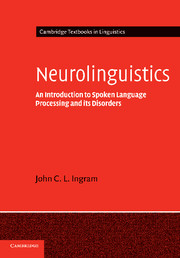Book contents
- Frontmatter
- Contents
- List of figures
- List of tables
- Preface and acknowledgements
- Note on the text
- Part I Foundational concepts and issues
- Part II Speech perception and auditory processing
- Part III Lexical semantics
- 9 Morphology and the mental lexicon
- 10 Lexical semantics
- 11 Lexical semantic disorders in aphasia
- Part IV Sentence comprehension
- Part V Discourse: language comprehension in context
- Glossary
- References
- Index
11 - Lexical semantic disorders in aphasia
Published online by Cambridge University Press: 26 January 2010
- Frontmatter
- Contents
- List of figures
- List of tables
- Preface and acknowledgements
- Note on the text
- Part I Foundational concepts and issues
- Part II Speech perception and auditory processing
- Part III Lexical semantics
- 9 Morphology and the mental lexicon
- 10 Lexical semantics
- 11 Lexical semantic disorders in aphasia
- Part IV Sentence comprehension
- Part V Discourse: language comprehension in context
- Glossary
- References
- Index
Summary
Introduction
The previous chapter's discussion of lexical semantics sought to address the fundamental problem of how word meanings are modified by context in sentence processing. These considerations are central to the goal of developing a combinatorial semantics of natural language processing – a task that is beyond the grasp of current theory or computation. However, it is important not to lose sight of the fact that words and idioms (phrase-like chunks of the kick-the-bucket variety) are also discrete linguistic entities, and that isolated word recognition, retrieval and production constitute a quasi-modular component of linguistic competence in its own right. Severe word-finding difficulties constitute a criterial symptom for a diagnosis of anomic aphasia or serve as a sign of incipient Alzheimer's disease. Phonemic or semantic paraphasias are characteristic features of fluent speech production in Wernicke's aphasia and may be accompanied by an agnosia (perceptual deficit) for the phonological form or the meanings of isolated words.
Indeed it has been argued that an initial stage of context-independent word recognition is required, in which all of the possible roles that a given word may play in different linguistic contexts are activated (perhaps in proportion to their likelihood of use), prior to the selective inhibitory or excitatory effects of context which rapidly constrain the system to settle on a dominant interpretation. This in fact was the conclusion to which Swinney (1979) was led in his celebrated ‘bug’ study of CMLP reported previously (chapter 10).
- Type
- Chapter
- Information
- NeurolinguisticsAn Introduction to Spoken Language Processing and its Disorders, pp. 221 - 240Publisher: Cambridge University PressPrint publication year: 2007

